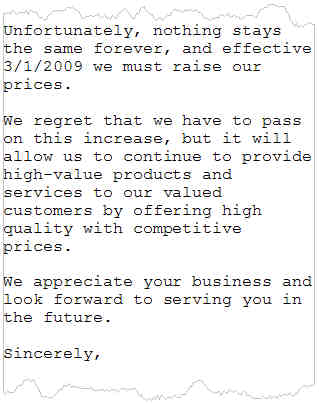Here’s how to raise prices in your health, fitness or wellness business. Clue #1: don’t do THIS:
Typical Badly-Planned, Poorly Communicated Price Increase Announcement
If your health club, corporate wellness program, yoga studio or wellness center hasn’t raised its prices yet, you’re probably thinking about it.
These strategies help you transform a potentially negative change into an opportunity to actually strengthen your customer and member relationships:
1. Start with value, not cost.
Your costs are irrelevant and uninteresting to your clients, customers and members. As far as they’re concerned, that’s your problem to manage.
Your business has to earn the right to raise prices by offering so much value to your customers that their reaction to an increase is:
“About time. In fact, I’d happily pay even more than that!”
Want to lose a customer? Send them a terse bureaucratic note that says “We haven’t raised our prices recently and costs have gone up so now we’re increasing our rates by 5%.” (That’s the postcard I just got from my health club, by the way.)
2. Remind them of past benefits.
Refresh their memory with a short recap of the difference you’ve made in their lives during the last year.
If you’re able to personalize it by pointing out specific accomplishments, great. At a minimum, point out new or enhanced products and services that your wellness business has added.
If your weight management program added new counseling features, mention them.
Perhaps you’ve upgraded your staff and you now employ only licensed healthcare professionals like RDs and physical therapists.
Your health club or fitness center probably added new equipment or updated your group fitness classes.
Or your yoga studio may have added yoga therapy or new styles of yoga.
Maybe you added free online events, or added a Zoom option to all of your programs, or added community outreach events like health fairs or public seminars or sponsored community or charitable events.
3. Excite them about the future.
Position your price increase as an investment that will pay off for your customer with even more benefits that they’ll enjoy over the upcoming months.
Planning to add a new fitness class? Or an affordably-priced sports league? Maybe you’re expanding your line of nutritional supplements or adding a new therapeutic modality at your wellness center. Perhaps you’ve lined up local physicians and dietitians who’ll offer free healthy living seminars.
Whatever you’re planning, tell your customers. Even if the details evolve as time passes, you’re reinforcing the notion that your business is committed to continually improving the customer experience.
4. Offer the “sleeves out of your vest”.
Pair a negative—the price increase—with a positive, something that your customer will value and that costs you little or nothing to offer.
For example, if your health club is raising its monthly fees, give every member who comes in on the first day of the month for the rest of the year a free bottle of water. Or include a booklet of healthy living tips or inspirational customer success stories written by your staff.
Another good option that can actually lead to additional revenues is a certificate for a complimentary health risk assessment or other free service.
5. Skyrocketing costs are a special case
Sometimes, despite your best efforts, a certain cost skyrockets. The most obvious example for wellness businesses whose health coaches and other health and wellness professionals travel to client sites was a sharp increase some years back in the price of gasoline. Fuel cost increases were widely reported and most consumers were aware that it was an across-the-board issue for everyone.
Customers may have some sympathy for these special-case increases, so in this situation it’s OK to briefly explain unusually high and hard-to-control cost spikes that have dramatically affected your business and necessitated a price increase.
Three words to the wise, however:
First, you STILL have to sell the value of what you’re providing. It doesn’t matter how well you explain the cost increase. If people simply don’t think your services are worth another $60/year, you’re cooked.
Second, “normal” cost increases are just part of doing business. Don’t expect sympathy from your customers if you’re blaming your price increase on higher costs in general. No one’s cutting them a break, right?
Third, be ready to drop your prices if that specific cost goes down. Shortly after per-gallon prices dropped, many water delivery services and drycleaners suspended the fuel surcharges that had previously added.
6. Toot your own horn
Take credit for your team’s careful cost management, and let your customers know that you’ve been able to minimize your price increase.
Did you negotiate a rent reduction for your health club, yoga studio or wellness center?
Maybe you switched from incandescent light bulbs to compact fluorescents.
Or invested in upgraded equipment that provides more uptime while reducing maintenance costs.
Did you add new fans to keep the workout area comfortable while saving on electricity?
Make sure they know that you actively control your costs while protecting and even enhancing their customer experience.
7. Consider strategic price increases
Targeted price increases avoid the risk of unintended customer attrition associated with across-the-board increases.
A strategic price increase is designed to eliminate a certain product, service, or customer segment with minimum hassle. Say you have a program that’s tough to keep staffed or is “high maintenance” for some other reason. But you don’t want the bad word-of-mouth associated with simply shutting it down.
Another way to accomplish the same result is simply to raise the price significantly. Customers will drop out of that program without the hard feelings that other approaches might cause.
8. Increase prices at least annually
Keeping prices flat and unchanged year after year is a bad idea. Over time, you become severely underpriced relative to the outside world. You’re charging $45/month for a service that customers would typically pay $75/month for.
That means you’re increasingly attractive to discount shoppers, who are likeliest to bail when you finally bite the bullet and raise your rates.
You’re forcing yourself to make a no-win decision. Would you rather forgo revenue while you make incremental increases over several years to avoid losing customers—or would you rather increase revenue much more quickly via a more aggressive increase, but lose lots more customers?
It’s wise to raise your prices at least annually, even if it’s a very small amount.
An increase of about 10% is quite common and not likely to cause sticker shock for most people. For example, if your memberships are currently $75/month, raising your prices to $82/month isn’t unreasonable. If your yoga studio’s class cards currently run $15, raising the price to $16 or $17 isn’t likely to cost you many students.
In general, prices go up, not down, and most businesses add cool new offerings every year, plus switching to another wellness business is a headache.
Most customers expect to pay a bit more and are happy to do so as long as the value’s there.




